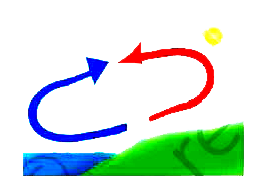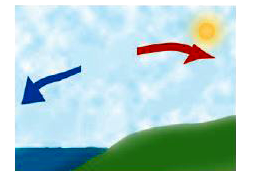Four schematic diagrams are shown in Figure 8.1 to depict the direction of sea breeze. Which of them gives the correct direction?




The correct Answer is:C
To determine which schematic diagram correctly depicts the direction of a sea breeze, we can follow these steps:
Step 1: Understand the Concept of Sea Breeze
- A sea breeze occurs due to the temperature difference between land and sea. During the day, the land heats up faster than the water, causing the air above the land to warm up, decrease in density, and rise.
Step 2: Analyze the Behavior of Air
- As the warm air rises over the land, it creates a low-pressure area. To fill this low-pressure area, cooler, denser air from the sea moves in to replace it, creating a breeze from the sea towards the land.
Step 3: Identify the Correct Diagram
- Look for a diagram that shows:
- Warm air rising from the land.
- Cool air coming in from the sea to replace the rising warm air.
Step 4: Evaluate the Options
- Among the four options presented, identify which one shows:
- Arrows indicating warm air rising (upward) from the land.
- Arrows indicating cool air moving in (downward) from the sea.
Step 5: Conclusion
- After analyzing the diagrams, the correct option that represents the sea breeze phenomenon is Option C, which shows warm air rising and cool air descending.
- A sea breeze occurs due to the temperature difference between land and sea. During the day, the land heats up faster than the water, causing the air above the land to warm up, decrease in density, and rise.
- As the warm air rises over the land, it creates a low-pressure area. To fill this low-pressure area, cooler, denser air from the sea moves in to replace it, creating a breeze from the sea towards the land.
- Look for a diagram that shows:
- Warm air rising from the land.
- Cool air coming in from the sea to replace the rising warm air.
Step 4: Evaluate the Options
- Among the four options presented, identify which one shows:
- Arrows indicating warm air rising (upward) from the land.
- Arrows indicating cool air moving in (downward) from the sea.
- After analyzing the diagrams, the correct option that represents the sea breeze phenomenon is Option C, which shows warm air rising and cool air descending.
Topper's Solved these Questions
- WIND, STORM AND CYCLONE BOOK - NCERT EXEMPLARCHAPTER - WIND, STORM AND CYCLONE EXERCISE - VERY SHORT ANSWER QUESTIONS
7 Videos
- WIND, STORM AND CYCLONE BOOK - NCERT EXEMPLARCHAPTER - WIND, STORM AND CYCLONE EXERCISE - VERY SHORT ANSWER QUESTIONS (FILL IN THE BLANKS)
4 Videos
- MOTION AND TIMEBOOK - NCERT EXEMPLARCHAPTER - MOTION AND TIMEEXERCISE - LONG ANSWER QUESTIONS
3 Videos
Similar Questions
Knowledge Check
The figure shows the path of a positively charged particle 1 through a rectangualr region of unifrom electric field as shown in the figure. What is the direction of electric field and the direction of deflection of particles 2,3 and 4 ?
 ATop, down, top, downBTop, down, down, topCDown, top, top, downDDiwn, top, down, down
ATop, down, top, downBTop, down, down, topCDown, top, top, downDDiwn, top, down, downSome equipotential surfaces are shown in figure . The magnitude and direction of electric field is
 A2V/cm at angle 120∘ with +ve x-axis in anticlockwise directionB2V/cm at angle 120∘ with +ve x-axis in clockwise directionC1V/cm at angle 150∘ with +ve x-axis in anticlockwise directionD1V/cm at an angle 120∘ with +ve x-axis in clockwise direction
A2V/cm at angle 120∘ with +ve x-axis in anticlockwise directionB2V/cm at angle 120∘ with +ve x-axis in clockwise directionC1V/cm at angle 150∘ with +ve x-axis in anticlockwise directionD1V/cm at an angle 120∘ with +ve x-axis in clockwise directionFor plane electromagnetic waves propagating in the z-direction , which one of the following combinations gives the correct possible direction for →Eand→B field respectively ?
A(−ˆi+ˆ2j)and(2ˆi−ˆj)B(−2ˆi−3ˆj)and(3ˆi−2ˆj)C(2ˆi+3ˆj)and(ˆi+2ˆj)D(3ˆi−4ˆj)and(4ˆi−3ˆj)
The schematic diagram of an open circuit is shown in the given figure.

Which of the following objects is inserted tightly in the gap to make the bulb glow?
View SolutionThe schematic diagram of an open circuit is shown in the given figure.

Opa ends Which of the following objects is inserted tightly in the gap to make the bulb glow?
View SolutionFour point charges, each of the same magnitude, with varying signs are arranged at the corners of square as shown in the figure below. Which of the arrows labelled A, B, C and D gives the correct direction of the net force that acts on the charge at the upper right corner ?

View SolutionFor plane electromagnetic waves propagating in the z-direction , which one of the following combinations gives the correct possible direction for →Eand→B field respectively ?
View SolutionA conductor in the form of a circular loop is carrying current I. The direction of the current is as shown. Then which figure represents the correct direction of magnetic field lines on the surfaces of the planes XY and XZ. (Consider those surfaces of the XY and XZ planes which are seen in the figure.)
View Solution

